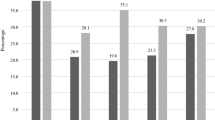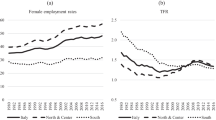Abstract
In this paper we consider the estimation of the causal effect of female labour market status (participation and employment) on fertility. We focus on the sensitivity of the estimated effect to (i) the assumptions about the exogeneity of labour market status; and (ii) the time interval between the measurement of fertility and employment status. Using Spanish quarterly data, we estimate a switching probit model that accounts for the joint determination of both variables. In order to obtain a behavioural effect of the former on the latter, we look at the timing of conception instead of the timing of birth, and present alternative sets of estimates depending on the accuracy with which conception is measured (yearly or quarterly). Our results show a positive although non-significant effect of participation and employment on the probability of having the first child, once the sample of women who conceive in the same quarter (or one quarter later) in which labour market status is measured and the endogeneity between both variables is accounted for. We find that annual data tend to over-estimate the negative effect of employment or participation on the probability of having a child, but the main biases appear when looking at the effect of participation.
Similar content being viewed by others
References
Angrist JD (2001) Estimation of limited-dependent variable models with dummy endogenous regressors: simple strategies for empirical practice. J Bus Econ Stat 19: 2–28
Angrist JD, Evans WN (1998) Children and their parents labor supply: evidence from exogenous variation in family size. Am Econ Rev 88: 450–477
Becker G (1960) An economic analysis of fertility. Demographic and economic change in developed countries. Universities-National Bureau of Economic Research Conference. Series 11 (NBER, Princeton, NJ)
Bloemen H, Kalwij A (2001) Female labor market transitions and the timing of births: a simultaneous snalysis of the effects of schooling. Labour Econ 8: 593–620
Browning M (1992) Children and household economic behaviour. J Econ Lit 30: 1434–1475
Carrasco R (2001) Binary choice with binary endogenous regressors in panel data: estimating the effect of fertility on female labour participation. J Bus Econ Stat 19: 385–394
Ermisch JF (1989) Purchased child care, optimal family size and mother’s employment. J Popul Econ 2: 79–102
Fleisher BM, Rhodes GF (1979) Fertility, women’s wage rates, and labour supply. Am Econ Rev 69: 14–24
Francesconi M (2002) A joint dynamic model of fertility and work of married women. J Labour Econ 20: 336–380
Guiterrez-Domenech M (2007) The impact of labour market on the timing on marriage and births in Spain. J Popul Econ, forthcoming
Hyslop DR (1999) State dependence, serial correlation and heterogeneity in intertemporal labour force participation of married women. Econometrica 67: 1255–1294
Hotz VJ, Klerman JA, Willis RJ (1997) The economics of fertility in developed countries. In: Rosenzweig MR, Stark O (eds) Chapter 7 in Handbook of Population and Family Economics
Hotz VJ, Miller RA (1988) An empirical analysis of life cycle fertility and female labour supply. Econometrica 56: 91–118
Kalwij AS (1999) Household consumption, female employment and fertility decisions: a microeconometric analysis. Ph.D. dissertation, Tilburg University
Kalwij AS (2000) The effects of female employment status on the presence and number of children. J Popul Econ 13: 221–239
Manski CF, Sandefur GD, McLanahan S, Powers D (1992) Alternative estimates of the effect of family structure during adolescence on high school graduation. J Am Stat Assoc 87: 25–37
Mincer J (1963) Market prices, opportunity cost and income effects. In: Christ C et al. (eds) Measurements in Economics: Studies in Mathematical Economics in honour of Yehuda Grunfeld, Standford University
Moffit R (1984) Profiles of fertility, labour supply and wages of married women: a complete life cycle model. Rev Econ Stud 51: 263–278
Shapiro D, Mott FL (1994) Long-term employment and earnings of women in relation to employment behaviour surrounding the first birth. J Human Resour 29: 248–275
Willis RJ (1973) A new approach to the economic theory of fertility behaviour. J Polit Econ 81: S14–S64
Wolfe B (1980) Chidbearing and/or labour force participacion: the education connection. Res Popul Econ 2: 365–385
Author information
Authors and Affiliations
Corresponding author
Additional information
We are grateful to Adrian Kalwij, Daniel Miles and two anonymous referees for helpful comments on this work. All remaining errors are our own.
Rights and permissions
About this article
Cite this article
Alba, A., Alvarez, G. & Carrasco, R. On the estimation of the effect of labour participation on fertility. Span Econ Rev 11, 1–22 (2009). https://doi.org/10.1007/s10108-008-9041-y
Published:
Issue Date:
DOI: https://doi.org/10.1007/s10108-008-9041-y




